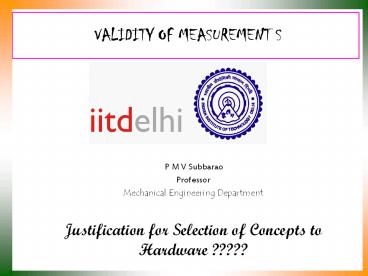VALIDITY OF MEASUREMENT S - PowerPoint PPT Presentation
1 / 10
Title:
VALIDITY OF MEASUREMENT S
Description:
VALIDITY OF MEASUREMENT S P M V Subbarao Professor Mechanical Engineering Department Justification for Selection of Concepts to Hardware ????? How To Measure Any ... – PowerPoint PPT presentation
Number of Views:133
Avg rating:3.0/5.0
Title: VALIDITY OF MEASUREMENT S
1
VALIDITY OF MEASUREMENT S
- P M V Subbarao
- Professor
- Mechanical Engineering Department
Justification for Selection of Concepts to
Hardware ?????
2
How To Measure Any Other Property?
- It is essential to invent a scientific principle,
which connects the property to be measured and
physical displacement/length/ Just a Real Number. - One needs to identify/ develop hardware which can
work as per the scientific principle. - What is the guarantee that the hardware exactly
works as per the principle? - How to develop high degree of confidence in a
measurement?
3
Validity of Measurement
- When we decide to study a variable, we need to
devise some way to measure it. - Some variables are easy to measure and others are
very difficult. - We try to develop the best measures we can
whenever we are doing research. - A good measuring instrument or test is one that
is reliable and valid. - Let us look at test validity first.
4
Test Validity
- Test Validity refers to the degree to which a
measuring strategy (instrument, machine, or test)
measures what is to be measured. - This sounds obvious right?
- A valid measure is the one that accurately
measures the variable being studied. - There are four/five ways to establish that your
measure is valid - Content validity
- Construct validity
- Predictive validity
- Concurrent validity
- Convergent validity and/or Discriminant validity.
5
Content Validity
- Content validity is established if your measuring
instrument samples from the areas of skill or
knowledge that compose the variable. - This assumes that you have a good detailed
description of the domain, something that's not
always true. - More the number of valid theories/skills, more
will be the number of measurement strategies. - Consider measurement of temperature
- Most popular valid theory for construction is ?
6
Coefficient of Thermal Expansion
material CTE (ppm/C)
silicon 3.2
alumina 67
copper 16.7
tin-lead solder 27
E-glass 54
S-glass 16
epoxy resins 15100
silicone resins 30300
- It is important to realise that
- The CTE is often not the same in all axes (that
is, not isotropic). - The CTE is rarely linear.
- The variation in CTE with temperature is only a
fairly smooth function if the material is
undergoing no phase transitions.
7
- Construct validity is the approximate truth of
the conclusion that the measurement accurately
reflects truth. - The degree of translation of property to be
measured into the measure. - Construct validity is based on designing a
measure that logically follows from a theory or
hypothesis. - Predictive validity, assesses the measurement's
ability to predict something it should
theoretically be able to predict. - Concurrent validity, assesses the measurement's
ability to distinguish between groups that it
should theoretically be able to distinguish
between. - Refers to the ability of any measure to separate
subjects who possess the attribute being studied
from those who do not. - Convergent validity assesses the degree to which
the measurement is similar to (converges on)
other measurements that it theoretically should
be similar to. - It is used when a valid measure exists for your
variable but you want to design another measure
that is perhaps easier to use or faster to take. - Discriminant validity, examines the degree to
which the measurement is not similar to (diverges
from) other measurement that it theoretically
should be not be similar to.
8
Ideas of Measurement Validation
9
Reliability
- Reliability is the consistency with which our
measure measures. - If you cannot get the same answer twice with your
measure it is not reliable. - A measuring strategy can be reliable and not
valid, but if the instrument is not reliable it
is also not valid. - Measurement is never exact.
- At some point our measures always break down and
errors creep into our data. - This is when the concept of Error of Measurement
becomes important. - In order to be able to use any measure we need to
know its error of measurement.
10
A good measuring strategy is reliable and,
because it is reliable, it has a small amount of
error in its observations.
The First Law of Measurements































